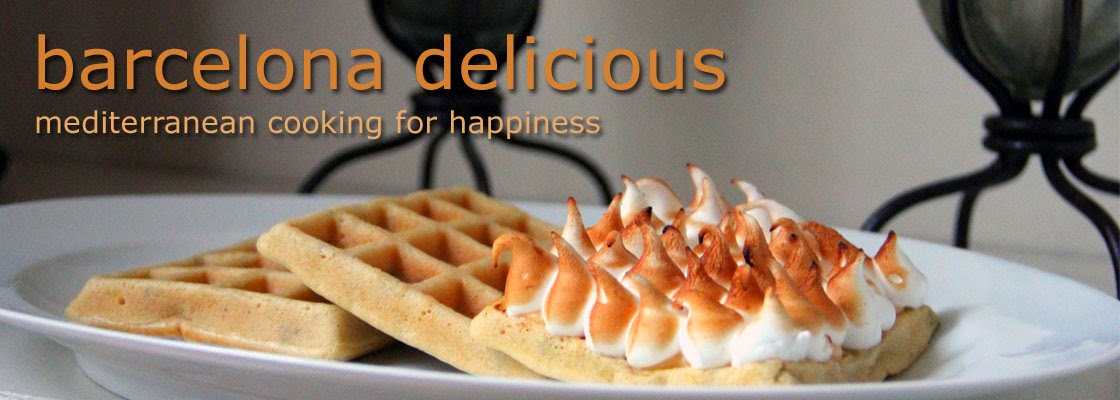English:
My family really enjoy this traditional Catalan dish;
sure you’ll like it too!!!!
400gr of thin noodles
10 prawns
3 chopped squids
A handful of clams (optional)
A handful of green peas
1l of fish stock
1 onion, sliced or minced
A clove of garlic
4 red tomatoes (boil the
tomatoes for 2 minutes and remove the skin)
A bay leaf
Salt, black pepper, paprika
(a half teaspoon)
1 teaspoon of sugar
Olive oil
Aioli sauce: this means garlic and oil, it’s basically
a garlic mayonnaise
2 or 1 peeled garlic cloves
1 egg yolk
Salt
Olive oil
Chopped and well mixed: 1 fried slice of bread, parsley, a clove of garlic, 6 toasted almonds, 6
toasted hazelnuts and 6 pine nuts.
Put the oil in a paella pan
over a medium-high heat; add a bay leaf and the clove of garlic, then add the
chopped onion. When the onion becomes golden, add the
sliced squids and the prawns into the paella. Fry them for 2 minutes, remove them and set aside.
Then, add the paprika and immediately add the boiled and chopped tomatoes, add
salt, pepper and a teaspoon of sugar. Stir a little.
Now, add the noodles, toast them slightly (be careful
not to brown them) season with salt.
Preheat the oven to 200ºC
Put the clams in a pot without water, over a
medium-high heat until they open. Do not pour the water off (clams release
water). We will add it to the fish stock to boil the noodles.
Then, add the fried squids and the fried prawns. Add the
green peas, the chopped mixture (garlic clove, pine nuts, almonds…) and the
warm fish stock to the pan, toss well. Stir and let it boil.
Place the paella pan in the oven for a few minutes,
until the liquid has been absorbed and the noodles get dry, golden and crispy.
Serve it with a little bit of aioli.
Aioli:
Mince the garlic with salt and paste well in a mortar
and pestle. Add the egg yolk, stir. Pour olive oil slowly until completely
incorporated. Stir constantly until the mixture has thickened.
Català:
A la meva
família els hi agrada molt aquest tradicional plat català; segur que us agradarà!!!
400gr
de fideus prims
10
gambes
3
calamars tallats a rodanxes
Un
grapat de cloïsses (opcional)
1
litre de brou de peix
1
ceba, tallada o picada
Un
grapat de pèsols
Un
gra d'all
4
tomàquets vermells (bullir els tomàquets durant 2 minuts i retirar la pell)
Una
fulla de llorer
Sal,
pebre negre, el pebre vermell (mitja culleradeta)
1
culleradeta de sucre
Oli
d'oliva
Allioli:
2 o
1 gran d'all pelats
1
rovell d'ou
sal
oli
d'oliva
La
picada: 1 llesca de pa fregit, julivert, un gra d'all, 6 ametlles torrades, 6
avellanes torrades i 6 pinyons.
Posarem
oli en una paella i encendrem el a foc a mitja potència; hi posarem una fulla
de llorer, el gra d'all i tot seguit hi tirarem la ceba picada o tallada a
rodanxes. Quan la ceba estigui daurada, hi posarem a la paella els calamars i les gambes. Els deixarem coure un parell de
minuts, aleshores traurem del foc les gambes i els calamars i ho reservarem. A
la paella hi tirarem el pebre vermell i immediatament els tomàquets cuits i
picats; ho salpebrem i també hi tirem una culleradeta de sucre. Remenarem i ho
deixarem coure una mica.
A
continuació, i hi tirarem els fideus, els deixarem torrar lleugerament, i hi
tirarem una mica de sal.
Encendrem
el forn a 200ºC de temperatura.
Posarem
les cloïsses en un pot o cassoleta sense aigua, a foc mig fins que s'obrin. No
llençarem l'aigua que deixen anar les cloïsses, l’afegirem a la paella quan hi
tirem el brou de peix.
Quan
tinguem els fideus una mica rossejats, hi posarem a la paella els calamars, les
gambes, els pèsols i la picada. Immediatament hi tirarem el brou de peix
calent. Ho remenem perquè quedi tot els ingredients ben repartits. Deixem que
bulli, hi col·loquem les cloïsses.
I posem
la paella al forn durant uns minuts, fins que el líquid s'hagi absorbit i els
fideus s’aixequin amunt.
Ho
servirem amb una mica d'all i oli.
All i oli:
Picar
els alls amb la sal dins un morter, afegir-hi un rovell d’ou. ho remenem. Quan
estigui ben barrejat comencem a tirar oli d'oliva (raig prim) mentre anem
remenant amb la mà de morter; de tan en tan pararem de tirar el raig d’oli per
remenar la barreja perquè vagi quedant ben lligada i no se’ns talli. Al remenar
constantment fa que la barreja s’espesseixi.
Espero
que gaudiu d’aquest plat tant com nosaltres !!!





No comments:
Post a Comment